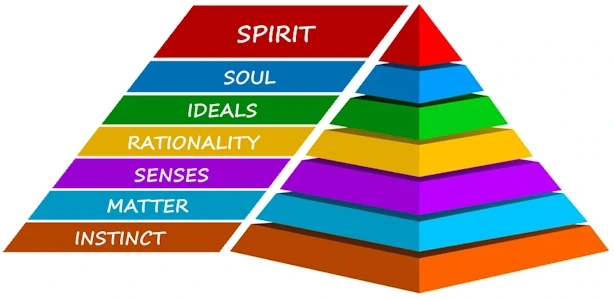
Introduction to the Tripartite Tractate
The Tripartite Tractate is a seminal text within the Gnostic tradition, encapsulating profound philosophical and spiritual insights that resonate with the complexities of existence, divinity, and the human condition. This work, part of the Nag Hammadi library discovered in 1945, is unique not only for its content but also for its stylistic approach to Gnostic thought. It presents a rich tapestry of metaphysical concepts that challenge conventional religious paradigms and invite readers into a deeper understanding of the divine.
Philosophical and Spiritual Aspects
At its core, The Tripartite Tractate articulates a vision of reality divided into three distinct yet interrelated realms: the divine fullness (Pleroma), the material world (Kenoma), and the intermediate state of humanity. The text begins with an exploration of the nature of God, who is described as “the One” or “the All”, transcending all attributes and limitations. This notion echoes Platonic ideals while simultaneously diverging from them by emphasizing an experiential knowledge of divinity rather than mere intellectual comprehension.
One poignant passage states: <<For it is through knowledge that one becomes free; it is through ignorance that one remains bound>>. This assertion underscores a central tenet of Gnostic belief: salvation comes not from faith alone but from gnosis—an intimate, experiential knowledge of the divine. The Tripartite Tractate posits that humanity exists in a state of forgetfulness regarding its true origin in the Pleroma, thus necessitating a journey back to this divine source.
The text further elaborates on the concept of dualism inherent in Gnosticism. It delineates between the spiritual realm, characterized by light and truth, and the material realm, often associated with darkness and deception. The author writes: <<The world was created by an inferior power>>, suggesting a critical stance towards traditional creation narratives found in canonical texts such as Genesis. This perspective positions the material world as flawed or illusory—a stark contrast to orthodox views where creation is deemed inherently good.
Insights and Theological Interpretations
The theological implications of The Tripartite Tractate are profound. It invites readers to reconsider their understanding of sin, redemption, and divine intervention. Rather than viewing sin as a transgression against divine law requiring punishment or atonement—as seen in many Abrahamic traditions—the Gnostic perspective emphasizes ignorance as humanity’s primary ailment. Redemption thus becomes an awakening to one’s true nature rather than merely seeking forgiveness.
Moreover, this text introduces complex figures such as Sophia (Wisdom), who plays a pivotal role in Gnostic cosmology. Sophia’s fall from grace leads to the creation of the material world—a narrative that parallels certain mythological themes found in other cultures but diverges significantly from Judeo-Christian accounts where creation stems directly from God’s will without any notion of error or fallibility.
Sophia’s journey reflects humanity’s own quest for enlightenment: <<She sought to know her own depth>>, which resonates deeply with existential inquiries about identity and purpose. In this way, The Tripartite Tractate serves not only as a theological treatise but also as an allegorical narrative about self-discovery.
Influence on Gnostic Tradition
The influence of The Tripartite Tractate on Gnostic thought cannot be overstated. Its emphasis on personal experience over dogma has shaped various sects within Gnosticism that prioritize individual interpretation and mystical experiences over institutionalized religion. This text acts as both a guide and an invitation to explore one’s inner landscape—a theme echoed throughout later Gnostic writings.
Furthermore, its dialectical method—juxtaposing different perspectives on existence—has inspired subsequent philosophical discourse within both Gnosticism and broader spiritual movements. By presenting multiple viewpoints on creation, divinity, and human destiny, it encourages readers to engage critically with their beliefs rather than passively accept them.
Unique Characteristics Compared to Other Gnostic Texts
What sets The Tripartite Tractate apart from other Gnostic texts is its systematic approach to cosmology combined with poetic language that evokes deep emotional resonance. Unlike other works such as The Gospel of Thomas or The Apocryphon of John—which often present fragmented sayings or mythological narratives—The Tripartite Tractate offers a coherent philosophical framework that systematically addresses key existential questions.
In comparison with canonical texts from Christianity—such as John’s Gospel which emphasizes faith in Christ for salvation—the Tripartite Tractate advocates for self-knowledge as essential for liberation from ignorance. Similarly, while Judaism places significant weight on covenantal relationships with God through law (Torah), this tractate suggests that true understanding transcends legalistic adherence; it lies instead in recognizing one’s inherent connection to divinity.
Islam’s teachings about submission (Islam) to God’s will stand in contrast to Gnostic ideals which promote individual exploration and realization over blind obedience. While Islamic mysticism (Sufism) shares some common ground with Gnosticism regarding inner experience and direct communion with God, Sufism still operates within an overarching framework established by Sharia law—something largely absent in Gnostic thought where personal revelation takes precedence over communal norms.
Comparisons with Canonical Texts
When The Tripartite Tractate is compared with the canonical texts of Christianity, Judaism and Islam, a number of differences become apparent.
Christianity
Canonical gospels such as the Gospel of John emphasize the importance of faith in Jesus Christ as the pathway to salvation. For instance, John 3:16 articulates a central tenet of Christian belief: <<For God so loved the world that he gave his one and only Son, that whoever believes in him shall not perish but have eternal life>>. This perspective underscores a relational dynamic between humanity and divinity centered on faith and grace.
In contrast, The Tripartite Tractate prioritizes personal knowledge (gnosis) as the means to achieve liberation from ignorance. It posits that understanding one’s true nature and relationship with the divine is crucial for spiritual awakening. This emphasis on knowledge rather than faith alone marks a significant departure from orthodox Christian teachings.
Judaism
Jewish texts such as Genesis articulate creation through divine command, encapsulated in phrases like: “And God said, <<Let there be light>>” (Genesis 1:3). This narrative reflects a monotheistic worldview where God is sovereign over creation without delving into dualistic interpretations or complex metaphysical constructs.
The Tripartite Tractate introduces concepts such as pleroma (the fullness of divine powers) and emanation (the process by which all things come forth from the divine source), which are characteristic of Gnostic thought. These ideas stand in stark contrast to Jewish theology, which does not engage with dualism or elaborate metaphysical hierarchies in its creation narratives.
Islam
Islamic theology emphasizes submission to Allah’s will as expressed through the Qur’an. The concept of tawhid (the oneness of God) serves as a foundational principle in Islam, contrasting sharply with Gnostic notions of multiple emanations or divine beings.
In summary, while all these religious traditions grapple with themes surrounding divinity and humanity’s purpose, they differ significantly in their approaches—particularly regarding authority structures (institutional vs individual), pathways to salvation (faith vs knowledge), and understandings of evil (moral failing vs ignorance).
Conclusion
In conclusion, The Tripartite Tractate represents a unique confluence of philosophy and spirituality within the Gnostic tradition. Its exploration of knowledge versus ignorance offers profound insights into human existence while challenging conventional religious doctrines across various faiths. By emphasizing personal experience over dogma and presenting a nuanced view of creation and divinity through allegorical narratives like Sophia’s journey, it invites readers into an expansive dialogue about their place within the cosmos.
Some Significant Quotes From the Tripartite Tractate
<<The non-existent has no place in the realm of being>>
This quote emphasizes the idea that true existence is rooted in the realm of being, and anything that does not truly exist cannot have a meaningful impact on our spiritual lives. It signifies the importance of distinguishing between the transient and the eternal.
<<In the fullness of the pleroma, all things are preserved in unity>>
This statement refers to the concept of the pleroma, or the fullness of divine presence. It suggests that in this state of ultimate unity, all beings and realities are interconnected, reflecting the wholeness of existence beyond the material world.
<<Knowledge is the key to understanding the divine>>
Here, the Tractate highlights the significance of knowledge as a means to access higher spiritual truths. It suggests that through gaining knowledge, individuals can unlock deeper insights into the nature of the divine and their own existence.
<<The soul’s ascent is hindered by ignorance and attachment>>
This quote encapsulates the idea that ignorance and attachment to the material world act as barriers to spiritual growth. It encourages individuals to transcend their worldly ties to elevate their souls toward enlightenment.
<<To know oneself is to know the divine>>
This powerful statement links self-knowledge with knowing the divine. It implies that understanding one’s true nature leads to a deeper comprehension of the divine presence within and around us, reinforcing the belief in the interconnectedness of all existence.
The Gnostic Texts Series
1. The Gnostic Gospels: Why Are They Interesting From a Spiritual Perspective?
2. Cosmology and Spirituality in The Book of Enoch
3. Sophia of Jesus Christ: Feminine Divine Wisdom in Gnostic Thought
4. Pistis Sophia: Gnostic Insights into Knowledge and Spirituality
5. The Apocalypse of Peter: Gnostic Insights on Morality and Judgment
6. The Nature of God in the Apocryphon of John: A Gnostic Interpretation
7. Spiritual Dualism in the Second Treatise of the Great Seth
8. Materiality and Spirituality in the Hypostasis of the Archons
9. The Tripartite Tractate: Bridging Gnosticism and Hellenistic Thought
10. Contrasting Beliefs: The Gospel of Thomas vs. Canonical Texts
11. The Gospel of Mary: Feminine Authority in Gnostic Spirituality
12. The Gospel of Truth: The Conception of Christianity According to Valentinus
13. The Gospel of Philip: Mary Magdalene’s Role and the Meaning of Sacraments
DO YOU HAVE A PHILOSOPHICAL MIND?
The philosophical quest is based on curiosity and the need to know. The philosopher is thirsty for knowledge and aware that the search for truth is a process that will never end. Are you truly a philosopher?
Read the sentences below and choose the ones you agree with and that you think make the most sense.
Count the number of checked boxes and read the corresponding profile.
0: Your mind is anti-philosophical
1-2: Your mind is unphilosophical
3-4: Your mind is prone to philosophy
5-6: You are a true philosopher




